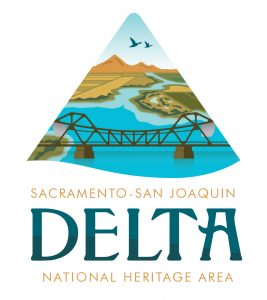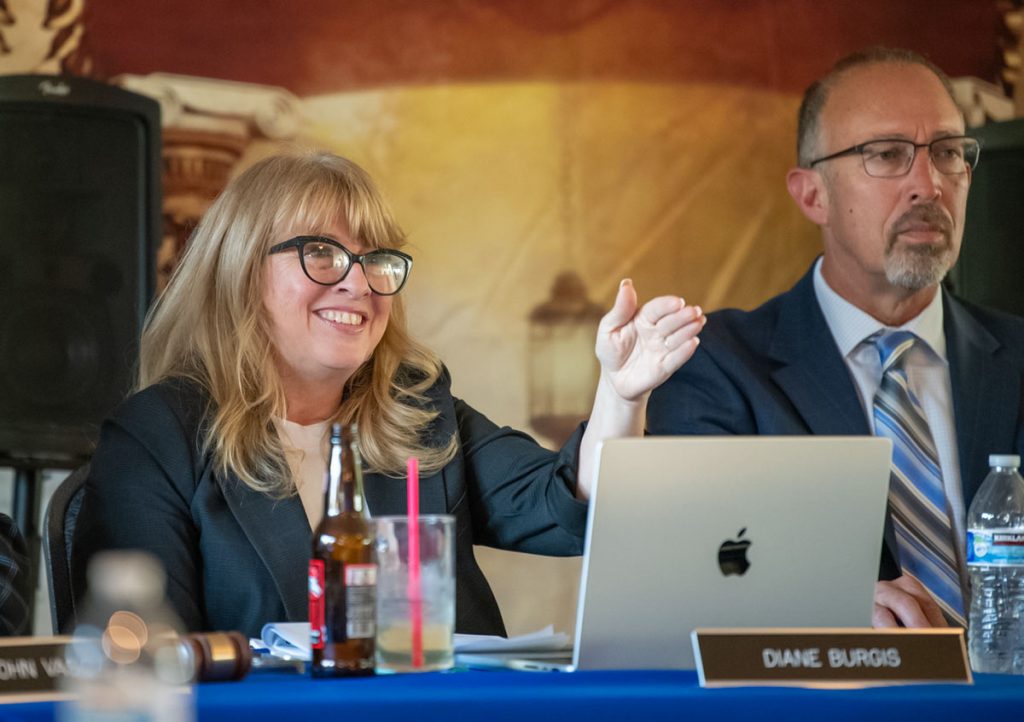OAKLEY, Calif. (July 19, 2024) – The Delta Protection Commission created a new advisory committee on Thursday to recommend policies, processes, and governance as the Commission implements the Sacramento-San Joaquin Delta National Heritage Area Management Plan.
The National Heritage Area Advisory Committee is governed by the charter approved Thursday. It succeeds the NHA Management Plan Advisory Committee, whose work is done now that the Management Plan has been submitted to the National Park Service.
In addition to advising the Commission, Committee members act as ambassadors to the diverse partners and communities in the NHA.
The committee is chaired by the Delta Protection Commission Executive Director or their designee, and has two members of the Delta Protection Commission and 12 members of the public. There will also be non-voting ex officio members representing the Legislature and public agencies.
Interested members of the public may apply to serve on this committee through 5:30 p.m. Aug. 16. The Delta Protection Commission is expected to make the appointments Sept. 19.
Committee members are expected to attend six bimonthly in-person meetings per year, which are held in the NHA at rotating locations. Four seats will expire in September 2025, four in September 2026, and four in September 2027. The expiration date for individual seats will be chosen randomly at the first NHA Advisory Committee meeting.
Apply for the openings here, or use the form below.
If you have questions, please email dpc@delta.ca.gov.

Top: Commissioners Paul Steele (left) and Jim Paroli (right). Bottom L-R: Commissioner Alan Nakanishi, NHA Advisory Committee Chair Elizabeth Patterson, DPC Program Manager Blake Roberts
HOOD, Calif. (March 7, 2024) – The Delta Protection Commission (DPC) today approved a draft of the Management Plan for the Sacramento-San Joaquin Delta National Heritage Area (Delta NHA) to submit to the Secretary of the Interior.
“There’s no place in the world like the Delta, with its unique geology, ecology, and history,” said Commission Chair Diane Burgis. “The Management Plan is our roadmap for how we talk about our history and how different agencies and community groups throughout the Delta’s five counties can work together to celebrate our shared heritage.
“Approving the Plan today is a big step toward receiving federal support and starting work on the ground,” she said.
The Commission’s action follows a 30-day public comment period on the draft plan. This is a critical part of the process, because unlike National Parks, National Heritage Areas are large, lived-in spaces. Local communities’ input is essential.
“We are so grateful to everyone who took time to attend meetings, review and comment on the draft Management Plan, and write letters of commitment,” said DPC Executive Director Bruce Blodgett. “Your input makes the plan stronger, and the partnerships that will come from letters of commitment ensure the Delta NHA becomes a vibrant resource that all Californians can be proud of.”
Among its supporters are members of the Delta’s Congressional Delegation: John Garamendi, Josh Harder, Ami Bera, Mike Thompson, Mark DeSaulnier, and Doris Matsui. They noted in support letters that approval of the management plan is key to unlocking funding authorized by Congress for the NHA – up to $10 million over 10 years.
The Delta National Heritage Area – the first and so far only NHA in California – was created in 2019 by Congress (PDF). It is one of 62 NHAs – places where historic, cultural, and natural resources create cohesive, nationally important landscapes.
The NHA’s boundary extends from Sacramento to Stockton to Vallejo with the junction of the Sacramento and San Joaquin rivers at its heart. The history of California’s Delta and Carquinez Strait is a rich tapestry of indigenous peoples and immigrants from around the world, natural beauty and wildlife and engineering marvels, bustling metropolitan areas and picturesque rural towns. The native peat soils provide for fertile cropland and its water supports 27 million Californians.
The Delta Protection Commission, a California state agency, was designated the local coordinating entity for the Delta NHA. It drafted the Management Plan in cooperation with the commission’s Delta NHA Management Plan Advisory Committee, the National Park Service, California State Parks, tribes, and stakeholders.
The Management Plan will now be submitted to the National Park Service, under the Secretary of the Interior, for approval, a process that could take six months. After federal approval, the plan will come back to the Commission for a final vote, and implementation of the plan can begin.
Media contact: Blake Roberts, (530) 650-6572 or blake.roberts@delta.ca.gov
 WEST SACRAMENTO, Calif. (Feb. 5, 2024) – The Delta Protection Commission today released a public-comment draft of the Management Plan for the Sacramento-San Joaquin Delta National Heritage Area (Delta NHA).
WEST SACRAMENTO, Calif. (Feb. 5, 2024) – The Delta Protection Commission today released a public-comment draft of the Management Plan for the Sacramento-San Joaquin Delta National Heritage Area (Delta NHA).
All interested parties are encouraged to view the plan here, and submit comments on the Plan by 5 p.m. March 6, 2024. Comments can be emailed to submit@delta.ca.gov, or mailed to the Delta Protection Commission, 2101 Stone Blvd., Suite 200, West Sacramento, CA 95691.
In addition, members of the public may attend one of two scheduled meetings to comment in person: Feb. 21 in Walnut Grove and Feb. 22 in Antioch, both 6-8 p.m. An additional virtual meeting will be scheduled as well.
“We’re excited and pleased to be at this juncture – a critical point in the development of this National Heritage Area,” said Commission Executive Director Bruce Blodgett.
“A great deal of work has gone into the plan in consultation with a broad group of stakeholders and tribes,” he said. “But this public comment process is key to ensuring that the voices of the Delta and all who depend on it – whether for work, recreation, historical and cultural appreciation, or spiritual connection – are represented well in the final plan.”
The Delta NHA was created in 2019 by Congress (PDF). It is California’s first, and so far only, National Heritage Area.
The NHA’s boundary extends from Sacramento to Stockton to Vallejo with the junction of the Sacramento and San Joaquin rivers at its heart. The history of California’s Delta and Carquinez Strait is a rich tapestry of indigenous peoples and immigrants from around the world, natural beauty and wildlife and engineering marvels, bustling metropolitan areas and picturesque rural towns. The native peat soils provide for fertile cropland and its water supports 27 million Californians.
The Delta Protection Commission, a California state agency, was designated the local coordinating entity for the Delta NHA. It has drafted the Management Plan in cooperation with the commission’s Delta NHA Management Plan Advisory Committee, the National Park Service, California State Parks, tribes, and stakeholders.
The Delta Protection Commission is scheduled to vote on the plan March 7, 2024, after which it will be submitted to the Secretary of the Interior for approval. After approval, implementation of the plan can begin.
Media contact: Blake Roberts, (530) 650-6572 or blake.roberts@delta.ca.gov

Delta Protection Commission Chair Diane Burgis
STOCKTON, Calif. (Sept. 21, 2023) – The Delta Protection Advisory Committee (DPAC) will gain a tribal representative under action taken Thursday by the Delta Protection Commission.
“It’s about engagement, opportunity and giving the tribes a voice on DPAC,” said Delta Protection Commission Executive Director Bruce Blodgett.
Commission Chair Diane Burgis, who also serves on the Contra Costa County Board of Supervisors, emphasized the importance of the perspective a tribal representative will bring.
“Native American tribes have thousands of years of deep memory of the Delta from before Europeans came,” she said. “Tribal voices should have a voice in how we manage our land and water. This is not us checking a box; Native knowledge will help us do a better job caring for the Delta.”
DPAC was created in 2009 by amendments to the 1992 Delta Protection Act. Whereas the Delta Protection Commission has majority representation from local government and water agencies, the Advisory Committee is composed of Delta stakeholders, including representatives in agriculture, recreation, natural resources, local communities and infrastructure.
Its role is to provide recommendations to the Commission regarding the Delta ecosystem, water supply, socioeconomic sustainability, recreation, tourism, agriculture, flood control, environment, water resources, infrastructure, Delta values and other Delta issues.
Tribal presence in the Delta
The Sacramento-San Joaquin Delta is critically important to modern-day Californians – with its fertile farmland, water that helps meet the needs of 27 million people, diverse recreation and tourism opportunities, and history-drenched network of small farm communities.
But prior to Spanish, Mexican, and American settlement, the Delta watershed was inhabited, carefully tended, and revered by diverse peoples: Bay Miwok, Coast Miwok, Plains Miwok, Maidu, Nisenan, Ohlone, Patwin, Pomo, Wappo, Wintun, and Yokuts.
Despite great resistance, their land was occupied by new settlers, and their populations decimated by disease and genocidal campaigns. But the descendants of these original inhabitants, including sovereign tribes, are still among us, and still carrying out traditional practices in the region.
Representatives of four tribes made clear their desire to be consulted early and often on matters affecting the Delta during a Tribal Listening Session held in April by the Delta Stewardship Council, another state agency. (Read about the session here, or watch a recording – the listening session starts at 2:49:22 and runs nearly to the end of the recording.)
The representatives – who spoke for the Buena Vista Rancheria of Me-Wuk Indians, Shingle Springs Rancheria of Miwok Indians, United Auburn Indian Community, and Paskenta Band of Nomlaki Indians – also emphasized their continuing wish to be guardians of the region, along with its other modern-day inhabitants and leaders.
DPAC’s new membership
In addition to getting a new tribal representative, DPAC will get another position representing the general public as a result of Thursday’s action – a unanimous vote – raising the total membership to 17.
With the expansion of the Committee approved, Commission staff will now develop an application process for the two new members, who will serve three-year terms.
DPAC is not the Commission’s only committee with tribal representation: Tribal representatives also serve on the Delta National Heritage Area Management Plan Advisory Committee, both as general and ex officio members. Their input has been crucial.
Additional resources:



 WEST SACRAMENTO, Calif. (Feb. 5, 2024)
WEST SACRAMENTO, Calif. (Feb. 5, 2024)